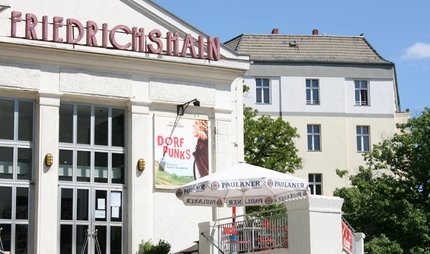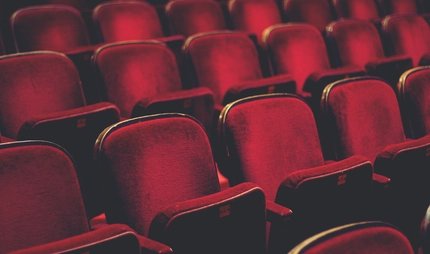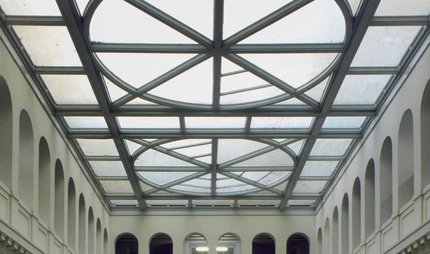
Kino International
Temporarily closed for refurbishment
The once most important premiere cinema of the former GDR and today known for its impressive architecture is currently being renovated and made fit for the future.
The first industrially manufactured residential buildings using the prefabricated construction method were built from 1959 to 1965 between Strausberger Platz and Alexanderplatz. The GDR thus broke away from the confectioner style of the Stalin era, whose buildings still characterise Karl-Marx-Allee to this day.
Yet the socialist housing complex on Karl-Marx-Allee in Mitte was intended to be more than just a place to live. From 1961 to 1964 it obtained its own urban centre: additional buildings for culture and conviviality, such as the Café Moskau, the Mokka-Milch-Eisbar and Kino International.
The design for these additional buildings was drawn up by the architect Josef Kaiser. As former head planner of the 'Stalinstadt' Eisenhüttenstadt, Kaiser oriented himself by the confectioner style at the beginning of the 1950s. He subsequently tried to catch up with developments in the West. The similarity of Kino International with the latest event buildings from West Berlin at the time – Zoo Palast and Deutsche Oper – was unmistakable.
An open house
The first floor of the cinema is a particular eye-catcher. It rises for nine metres over the façade of the ground floor without columns – and as such appears to float. The cinema hall is also to be found on the first floor. For an audience of originally 600, it boasted state-of-the-art equipment at the time of opening: for example, a wide screen in cinemascope format and acoustics perfectly adapted to the room.
The façade of the upper floor is covered with a huge window front – interrupted only by the current film poster, which is still hand-painted to this day. With the glass façade, Kaiser wanted to underline the importance of the cinema as an open house for all residents and visitors. Everyone should feel welcome – the building had more to offer than a cinema. In GDR times, the youth club Klub International organised concerts with new bands. The district library was also housed in the premises.
Utopia and reality
If you have the opportunity to visit Kino International, don't just look at the front façade with the panoramic window. Walk around the building once. You will notice that the other three sides have no windows at all. They consist of a relief by the artists Waldemar Grzimek, Karl-Heinz Schamal and Hubert Schiefelbein. Their 14 concrete casting plates bear the title Aus dem Leben heutiger Menschen (From the lives of today's people), but in truth show a utopian vision of the future: an engineer who controls futuristic machines. A manual labourer whose physical strength is no longer needed and who is therefore studying a book.
The contradiction between utopia and practice was not only visible in the façade. If the Socialist Unity Party of Germany (SED) regime found films to be too critical, it terminated them prematurely. Nevertheless, those in power at the time were also aware of the reality to some extent: Kino International had to show Western productions in order to finance itself. This led to an exciting programme mixture. At Kino International, award-winning GDR productions such as Solo Sunny were premiered, as were selected films from the West such as Cabaret and Dirty Dancing.
The GDR collapsed in 1989/90, but Kino International remained. In 1992 the Yorck Group acquired the building, which it has been operating ever since. Here, European and independent productions were shown, even in their original versions. The listed building was also the venue of the Berlinale. Whether it be Robert Redford, Steven Spielberg, Tilda Swinton or Wim Wenders – the greats of the international film scene have all been guests here in the past.
Our tips for nearby Kino International
You should not miss out on a visit to Kino International. Before watching a film, spend time relaxing in the panorama bar with its excellent view of Karl-Marx-Allee thanks to the glass façade. Kino International is not only a cinema, but also an event location. In the place where the GDR state leadership used to retire to after film premieres, events are taking place today, for example on New Year's Eve. Within walking distance you can discover other modern Berlin buildings from GDR times: take a look at Josef Kaiser's Café Moskau, the Mokka-Milch-Eisbar and the confectioner buildings of the former Stalinallee [internal links] east of Strausberger Platz.
Practical tips from visitBerlin
Kino International can be reached by taking the U-Bahn line 5 to the Schillingstraße U-Bahn station. To explore the city, we recommend the Berlin WelcomeCard for public transport.
The cinema is currently closed



